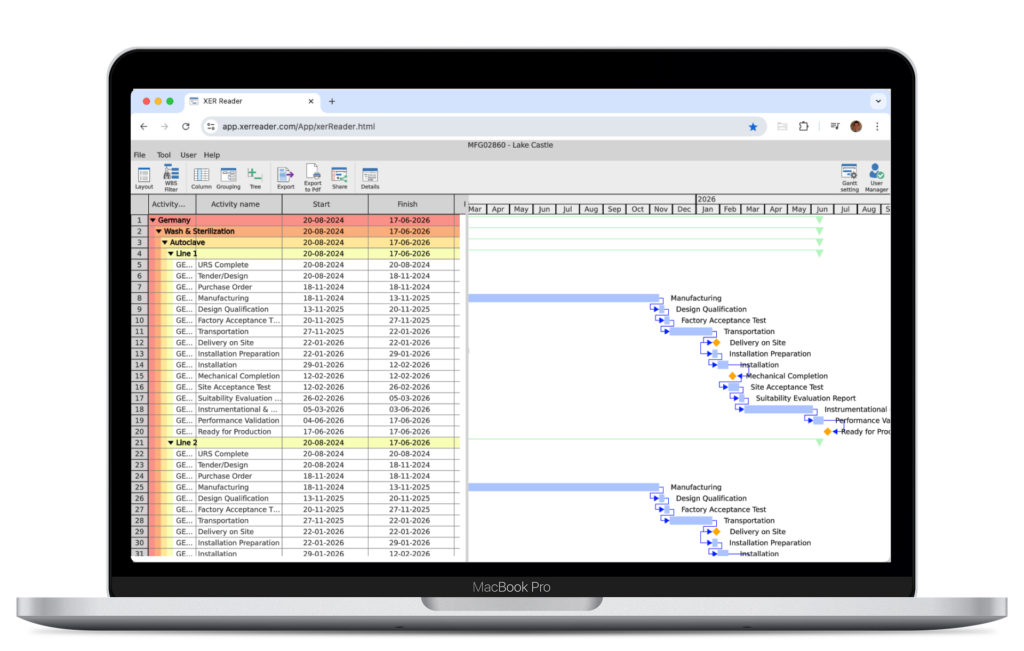Comprehensive How-To For Streamlined P6 Scheduling

There’s no denying that effective scheduling is vital for the success of any project. In this guide, you will discover a comprehensive approach to streamline your P6 scheduling process, enabling you to optimise resource allocation and enhance project timelines. By following these steps, you will empower yourself with the tools and techniques needed to manage your projects with greater efficiency and clarity. Let’s examine the crucial strategies that will transform your scheduling practices.
Types of P6 Scheduling
The types of scheduling in Primavera P6 are fundamental for effectively managing your projects. You can choose from several distinct methods, each suitable for different project requirements. Here’s an overview of the main types:
| Type | Description |
|---|---|
| Traditional Scheduling | Focuses on sequential tasks with fixed milestones. |
| Agile Scheduling | Emphasises flexibility and iterative progress. |
| Hybrid Scheduling | Combines both traditional and agile methodologies. |
| Resource Scheduling | Allocates resources based on project needs. |
| Critical Path Method | Identifies key tasks and dependencies. |
Traditional Scheduling
The traditional scheduling method in P6 revolves around a structured approach, focusing on a linear sequence of tasks. You will establish clear, fixed deadlines and milestones that guide your project’s progression. By utilising this method, your project maintains a definitive timeline, which can be particularly beneficial for projects with straightforward requirements.
Agile Scheduling
Any project utilising agile scheduling is designed for adaptability and responsiveness. You’ll thrive in a dynamic environment where requirements can evolve over time, allowing for iterative progress through short cycles. This approach encourages regular reassessments and adjustments, ensuring that your project can incorporate feedback promptly.
To maximise your project’s effectiveness, you must emphasise collaboration among team members through regular stand-up meetings and continuous integration. Agile scheduling thrives on incremental developments, allowing you to prioritise tasks flexibly and deliver value early and often to stakeholders.
Hybrid Scheduling
Types of hybrid scheduling in P6 blend elements of both traditional and agile methodologies. You can benefit from the structure of traditional scheduling alongside the flexibility of agile practices. This dual approach allows you to navigate uncertainties while keeping the overall project timeline intact.
Plus, hybrid scheduling enables you to adapt to changing project requirements without losing sight of your deadlines. By integrating both techniques, your team can better respond to shifts in priorities, ultimately leading to improved project outcomes and stakeholder satisfaction.
Step-by-Step Guide to Creating a Streamlined Schedule
If you are looking to enhance your P6 scheduling, following a step-by-step guide can significantly improve your approach. Below is a breakdown of the crucial steps:
| Step | Description |
| 1 | Initial Project Setup |
| 2 | Defining Activities and Milestones |
| 3 | Assigning Resources |
Initial Project Setup
You should begin by defining the overall objectives of your project and setting up an efficient framework in P6. This involves creating a new project, specifying project dates, and establishing the work breakdown structure (WBS).
Defining Activities and Milestones
Schedule your project’s activities and milestones by breaking down the WBS into manageable tasks. Each activity should have clear deliverables and a timeline to keep your schedule on track.
Another important aspect of defining activities is ensuring that milestones accurately reflect the project’s progress. Milestones should not only indicate significant achievements but also be strategically placed to allow for proper tracking and adjustments as required.
Assigning Resources
Any project requires adequate resource allocation to ensure tasks are completed efficiently. You need to assign the right resources to each activity based on expertise and availability.
To effectively manage your schedule, compare your resource assignments against their availability and workloads. Balancing your resources helps optimise performance and ensures no team members are overwhelmed, making it easier to stay on schedule.
Key Factors Influencing Effective Scheduling
After understanding the nuances of scheduling, you must consider several factors that can significantly influence your project’s effectiveness. These include:
- Project scope and complexity
- Resource availability
- External constraints
The alignment of these elements ensures a smoother scheduling process and project execution.
Project Scope and Complexity
There’s no denying that the intricacies of your project’s scope and its complexity are fundamental in shaping your scheduling decisions. A detailed understanding of the project’s requirements allows you to structure timelines efficiently, accounting for all variables involved.
Resource Availability
There’s a direct correlation between your project’s success and the availability of resources at your disposal. Ensuring that you have access to the right personnel, equipment, and materials is vital for maintaining your schedule.
For instance, if your team members have conflicting commitments or if imperative materials are delayed, your schedule may become compromised. You should continuously assess resource allocation and make adjustments to keep your project on track.
External Constraints
One major factor to be aware of is the presence of external constraints that might impact your scheduling efforts. These can include regulatory requirements, client expectations, and weather conditions, all of which could impose significant limitations on your project.
Complexity in external constraints can lead to unforeseen challenges that require swift adaptability. By proactively identifying these constraints, you can create contingency plans that mitigate potential delays and ensure your project remains aligned with its intended timeline.
Tips for Enhancing Schedule Efficiency
To maximise your schedule efficiency, consider the following strategies:
- Prioritise tasks to focus on high-impact activities.
- Utilise resources effectively to avoid bottlenecks.
- Set realistic deadlines to maintain project momentum.
- Encourage team collaboration for improved insights.
- Incorporate buffer times to handle unforeseen issues.
Perceiving the interconnectedness of these tips will lead to a more streamlined scheduling experience.
Regular Updates and Monitoring
If you consistently update and monitor your schedule, you will better manage timelines and resources, ensuring that your project stays on track. Regular reviews also allow you to adjust for any changes that may arise throughout the project lifecycle.
Effective Communication
Any successful project relies on effective communication among team members. Clear messaging ensures that everyone is aligned with project goals and timelines, reducing the potential for misunderstandings that can disrupt your schedule.
Efficiency in communication can be leveraged through various tools that facilitate information sharing, ensuring that all stakeholders are informed. Regular status meetings, emails, and instant messaging can serve to keep everyone updated. Additionally, using collaborative platforms allows for real-time updates, fostering better teamwork, and enhancing overall productivity.
Using Advanced P6 Features
Assuming you are familiar with P6, you can further enhance your scheduling with advanced features, such as:
- Activity Codes for categorising tasks.
- Global Change for bulk updates.
- Layouts for customised views.
- Resource Assignments for optimised workload management.
- Reporting tools for performance assessment.
Tips for leveraging these tools effectively include regularly exploring P6’s functionalities and seeking training to maximise your knowledge and capabilities.
Enhanced P6 Features
| Feature | Description |
| Activity Codes | Allows for grouping and sorting tasks based on certain criteria. |
| Global Change | Enables bulk modifications across the schedule, improving efficiency. |
| Layouts | Customised views for better project visibility and focus. |
| Resource Assignments | Improves the allocation and tracking of resources across tasks. |
| Reporting tools | Facilitates tracking project progress and identifying delays. |
Pros and Cons of P6 Scheduling
Now, it is imperative to evaluate both the advantages and disadvantages of P6 scheduling to make an informed decision that suits your project management needs.
| Pros | Cons |
|---|---|
| High level of customisation | Steep learning curve for beginners |
| Robust reporting capabilities | Can be expensive for small teams |
| Integrates with other software | Time-consuming to set up |
| Supports large projects | Requires strong computing resources |
| Enhanced collaboration features | Ongoing software updates can be disruptive |
Advantages of Using P6
Little doubt exists regarding the many advantages of using P6 for project scheduling. Its ability to handle complex projects and a wide range of features makes it an ideal choice for project managers seeking a comprehensive tool. You can benefit from its customisation, robust reporting, and collaboration capabilities, allowing for effective communication among your team members and stakeholders.
Potential Drawbacks to Consider
An important consideration when opting for P6 is its potential drawbacks. While it offers extensive features, the complexity may be overwhelming for less experienced users, and the cost can be prohibitive for smaller projects and teams.
Understanding these challenges is vital for your success in utilising P6. The steep learning curve and resource requirements may lead to initial inefficiencies, making it imperative that you invest time and effort into training your team. Additionally, if your projects are on a smaller scale, you might find alternative scheduling software more suited to your needs in terms of cost and simplicity. By weighing both the benefits and drawbacks, you can better assess if P6 aligns with your project management goals.
Conclusion
From above, you can see how a streamlined P6 scheduling process can elevate your project management practices. By implementing the comprehensive strategies outlined, you can enhance efficiency and maintain control over your timelines. With the right tools and techniques, you will find it easier to manage your schedules, allocate resources effectively, and ultimately achieve successful project outcomes. Embrace these methods, and you will undoubtedly optimise your scheduling process.
FAQ
Q: What is the purpose of streamlined P6 scheduling?
A: Streamlined P6 scheduling aims to enhance project management efficiency by simplifying the process of planning, executing, and monitoring project schedules. It allows project managers to effectively allocate resources, track progress, and make informed decisions, leading to a more organised workflow and successful project outcomes.
Q: How can I implement a streamlined approach to P6 scheduling in my organisation?
A: To implement a streamlined approach, begin by assessing your current scheduling practices and identifying areas for improvement. Standardise processes across projects, utilise templates and tools available within P6, and provide training to your team on best practices in scheduling. Regularly review progress and gather feedback to refine your approach.
Q: What are the benefits of using comprehensive how-to guides for P6 scheduling?
A: Comprehensive how-to guides provide step-by-step instructions that help users navigate complex features of P6, making it easier to create and manage schedules. They enhance understanding of the software’s functionalities, promote consistency in scheduling practices, and can significantly reduce the learning curve for new users, thereby improving overall project efficiency.









